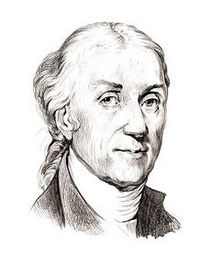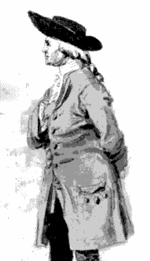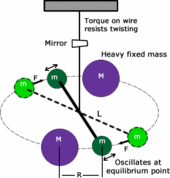Henry Cavendish
By yan49

Personal Life

Early Life
Henry Cavendish was born in Nice, France on October 10 ,1731. His father was Lord Charles Cavendish and his mother was Lady Anne Grey who died soon after Henry Cavendish was born. His family lineage traces across eight centuries and is closely connected to many wealthy families of Great Britain. He attended Dr. Newcomb's Hackney Academy in Hackney, England as a child. In 1749, he attended Peterhouse, Cambridge, but he left without a degree after three years. Because he was so shy, there are rumors that he was autistic. He did not socialize with anyone other than his close scientific colleagues.
Adulthood
After he left Cambridge, Henry Cavendish moved back to London to live with his father. He built a laboratory and a workshop there. He moved the laboratory to Clapham Common when his father died in 1783. Henry Cavendish never married and was very reserved, so there are not many records of his social life.
Death
Henry Cavendish died in London, England on February 24, 1810. He was known to be one of the wealthiest men in Britain, and he was buried in Derby Cathedral among many of his ancestors.
Scientific Work
Cavendish was a physicist and a chemist who determined the value of the universal constant of gravitation, created great impact on electrical studies, and discovered hydrogen and the composition of water. He was able to calculate the Earth's mass and introduced the concept of voltage.
Although Cavendish did not publish many works of his brilliant findings, his accuracy and precision in his findings are noted very impressive, and he set a new standard of accuracy in analytical chemistry.
"Inflammable Air"
Cavendish did most of his studies with quantitative measurements. Cavendish noticed that when zinc or iron was dropped into an acid, gas would form. He called this gas that would be produced "inflammable air" which turns out to be hydrogen. He was able to recognize this phenomenon when he calculated the densities of different gases. He noticed that when he burned a certain gas, it produced dew which he later found to be water. It was also much less dense than air. The formation of inflammable air was due to the action of dilute acids which are weakened acids on metals. Because he was wealthy, his equipment would have allowed him to measure precisely. Cavendish found that regular air is made up of nitrogen in a 4:1 ratio by volume. He also did studies in measuring heats of fusion and evaporation.
He would glint air with excess oxygen over alkali until there was not more absorption, and he noticed that a tiny amount of gas could not be further reduced. He finalized that gases that do not reduce to nitrous acid is no more than 1/120 part of the whole, and these gases are now known as noble gases.
His research on combustion made great contribution because he determined the composition of water (oxygen and hydrogen). This study was reported in an experiment by Joseph Priestley in which an explosion of two gases left moisture on previously dry surfaces. Expanding on this study, Cavendish studied this and got an approximate mathematical figure for its volume composition.
Cavendish also studied products of fermentation. Fermentation is a chemical reaction that divides complex organic compounds into simple molecules. He proved that the gas from fermentation is almost the same as the fixed air from chalk and magnesia which is modern day carbon dioxide.
Electrical Studies
Henry Cavendish compared the conductivity of equal solutions of electrolytes and concluded a version of Ohm's law which states that the current through a conductor between two points is directly proportional to the potential difference across the two points. Although he did not publish many of his works, his colleagues were more than convinced that his conclusions were correct. Cavendish was not the first to explore an inverse-square law of electrostatic attraction, but his idea was the most effective because it was based on mathematical reasoning as well as electrical knowledge.
Cavendish was one of the first to explore conductivity in aqueous solutions. Although pure water does not conduct electricity, when there is a conductor, for example, salt, in the water, it is able to conduct electricity. He was able to find this by making a fish out of leather and wood soaked in salt water that represent organs of fish. He charged the imitation organs with Leyden jars to show that the results proved that the fish was able to produce electricity.
"G" - The Gravitational Constant

Henry Cavendish is also known for the Cavendish experiment in which he measured the force of gravity between masses in a lab in order to produce an accurate value for Earth's density. The machine he used was designed by Rev. John Michell, but Cavendish reconstructed many of the important parts. The machine depended on measuring the attraction on a horizontal bar that is suspended by a wire. The bar had a small lead ball at each end by two large masses of lead. Based on his results, the value for the gravitational constant is
 and in modern days, the gravitational constant is about
and in modern days, the gravitational constant is about

From this, we can see that Cavendish's value was very close to the modern day value.
Awards
Because Cavendish did not publish many of his works, he does not have as much recognition in awards as expected. However he did receive the Royal Society's Copley Medal for his paper on "factitious airs" which was his first publication of a combination of three short chemistry papers.
See Also
Further Reading
Cavendish, Christa Jungnickel and Russell McCormmach, American Philosophical Society, 1996, 414 pp.
Cavendish: The Experimental Life, Christa Jungnickel and Russell McCormmach, Bucknell University Press, 1999, 814 pp.
External Links
http://www.chemistryexplained.com/Bo-Ce/Cavendish-Henry.html
References
http://www.chemistry.mtu.edu/~pcharles/SCIHISTORY/HenryCavendish.html
http://www.notablebiographies.com/Ca-Ch/Cavendish-Henry.html